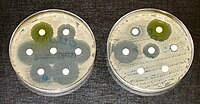
Photo from wikipedia
Purpose Due to the extensive consumption of silver-containing compound, silver resistance spreads among gram-negative pathogens and is regarded as a great public problem. In this study, we investigated silver resistance… Click to show full abstract
Purpose Due to the extensive consumption of silver-containing compound, silver resistance spreads among gram-negative pathogens and is regarded as a great public problem. In this study, we investigated silver resistance mechanisms and antibiotic resistance genes co-harbored with sil operon among gram-negative pathogens isolated from wound samples. Methods A total of 193 strains of gram-negative pathogens were collected from wound samples between 2018 and 2020 in Xiangya hospital. Silver resistance was obtained by broth microdilution method. The silver resistance mechanisms and the prevalence, genetic environments, and coexistence with antibiotic resistance genes of sil operon were investigated by polymerase chain reaction (PCR) and whole genome sequencing (WGS). Results Among 193 strains, nine strains (4.7%) were resistant to Ag+ and assigned to the following species: Klebsiella pneumoniae (n = 5) and Enterobacter hormaechei (n = 4). WGS confirmed that 24 strains carried the entire sil operon, including the four Ag+-resistant E. hormaechei and 20 Ag+-susceptible strains, while PCR failed to detect some sil genes, especially silE, due to sequence variations. In seven strains, Tn7 transposon was identified in the upstream of sil operon. Spontaneous mutants resistant to Ag+ were induced in 15 out of 20 Ag+-susceptible strains, including K. pneumoniae strains belonged to high-risk groups (ST11 and ST15). The sil-positive strains harbored various antibiotic resistance genes, including blaESBL and blaApmC. WGS revealed that a single mutation in cusS gene and loss of major porins conferred silver resistance in the five K. pneumoniae strains. Conclusion Our findings emphasize the cryptic silver resistance is prevalent among Enterobacteriaceae with sil operon or with the combination of cus operon and major porin loss and increase the understanding of the prevalence of sil operon with antibiotic resistance genes, especially blaESBL and blaApmC.
Journal Title: Infection and Drug Resistance
Year Published: 2022
Link to full text (if available)
Share on Social Media: Sign Up to like & get
recommendations!